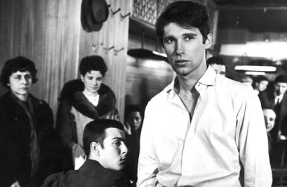Learning to Live Together

“Nevertheless, what are truly characteristic of dreams are only those elements of their content which behave like images, which are more like perceptions, that is, than they are like mnemic presentations.” Written, as it was, in historical parallel with the moment of cinema’s birth, it is tempting to invert Dr. Freud’s argument and understand it as the earliest theory of one major strain of cinematic production, that one whose roots took hold in the last years of the ’20s and whose first full blossoms were brought forth by Maya Deren. Since Meshes of the Afternoon (1943), much of the most sophisticated filmmaking has given its energies to the creation of images which are, before anything else, opportunities for fresh and startling perception, as opposed to inducements to recognition and remembrance (the latter being, with few exceptions, the model on which commercial feature films, popular or esoteric, are constructed). The British filmmaker Beatrice Gibson provides acute examples of these mechanics. Gibson has made, to my mind, three major works to date—Agatha and The Tiger’s Mind (both 2012), and this year’s I Hope I’m Loud When I’m Dead—and what follows traces an arc along which their intricate surfaces are reoriented from internal to external reflection.
is based quite literally in the realm of dreams: it “adapts” a dream had by the experimental composer and musician Cornelius Cardew, whose work and ideas on “experimental notation” were the focus of Gibson’s doctoral study at Goldsmiths (his score of the same name provides the basis for ). The film’s soundtrack is filled from end to end by Gibson’s reading of a lightly condensed iteration of Cardew’s dream transcription, a “sexual reminiscence” involving an ambiguous figure who finds him- or herself on a distant planet as part of an equally ambiguous scientific excursion. The narrator then comes to be intimately involved with a pair of locals called, “for the sake of convenience in narrative,” Agatha and Gladys. That they are gendered as female in the narration solely because the speaker would “prefer to make them feminine and leave my own sex in doubt, rather than declare myself a man and leave their sex in doubt” points to a loose thread which we will return to below. The narrator, whom I will call Cornelius, abandons their formal research almost immediately upon arrival, preferring instead to “walk the erratic network of lanes that served the countryside, sniffing the local flora.” It is on these walks that Cornelius meets Gladys, a member of “a dignified and rustic race with no technology, and no desire for it.”
You’re reading a preview, subscribe to read more.
Start your free 30 days





